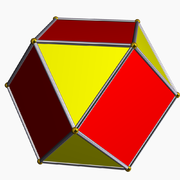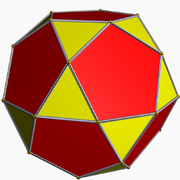- Cuboctahedron
-
Cuboctahedron 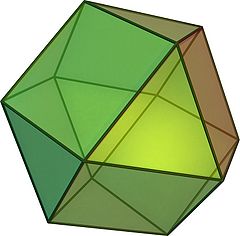
(Click here for rotating model)Type Archimedean solid
Uniform polyhedronElements F = 14, E = 24, V = 12 (χ = 2) Faces by sides 8{3}+6{4} Schläfli symbol t1{4,3}
t0,2{3,3}Wythoff symbol 2 | 3 4
3 3 | 2Coxeter-Dynkin 









Symmetry Oh, [4,3], (*432)
Td, [3,3], (*332)Dihedral Angle 125.26°

References U07, C19, W11 Properties Semiregular convex quasiregular 
Colored faces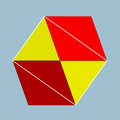
3.4.3.4
(Vertex figure)
Rhombic dodecahedron
(dual polyhedron)
NetIn geometry, a cuboctahedron is a polyhedron with eight triangular faces and six square faces. A cuboctahedron has 12 identical vertices, with two triangles and two squares meeting at each, and 24 identical edges, each separating a triangle from a square. As such it is a quasiregular polyhedron, i.e. an Archimedean solid, being vertex-transitive and edge-transitive.
Its dual polyhedron is the rhombic dodecahedron.
Contents
Other names
- Heptaparallelohedron (Buckminster Fuller)[1]
- Fuller applied the name "Dymaxion"[1] and Vector Equilibrium[2] to this shape, used in an early version of the Dymaxion map.
- With Oh symmetry, it is a rectified cube or rectified octahedron (Norman Johnson)
- With Td symmetry, it is a cantellated tetrahedron.
- With D3d symmetry, it is a triangular gyrobicupola.
Area and volume
The area A and the volume V of the cuboctahedron of edge length a are:
Images
Orthographic projections 

Cartesian coordinates
The Cartesian coordinates for the vertices of a cuboctahedron (of edge length √2) centered at the origin are:
- (±1,±1,0)
- (±1,0,±1)
- (0,±1,±1)
An alternate set of coordinates can be made in 4-space, as 12 permutations of:
- (0,1,1,2)
This construction exists as one of 16 orthant facets of the cantellated 16-cell.
Root vectors
The cuboctahedron's 12 vertices can represent the root vectors of the simple Lie group A3. With the addition of 6 vertices of the octahedron, these vertices represent the 18 root vectors simple Lie group B3.
Geometric relations
A cuboctahedron can be obtained by taking an appropriate cross section of a four-dimensional 16-cell.
A cuboctahedron has octahedral symmetry. Its first stellation is the compound of a cube and its dual octahedron, with the vertices of the cuboctahedron located at the midpoints of the edges of either.
The cuboctahedron is a rectified cube and also a rectified octahedron.
It is also a cantellated tetrahedron. With this construction it is given the Wythoff symbol: 3 3 | 2.

A skew cantellation of the tetrahedron produces a solid with faces parallel to those of the cuboctahedron, namely eight triangles of two sizes, and six rectangles. While its edges are unequal, this solid remains vertex-uniform: the solid has the full tetrahedral symmetry group and its vertices are equivalent under that group.
The edges of a cuboctahedron form four regular hexagons. If the cuboctahedron is cut in the plane of one of these hexagons, each half is a triangular cupola, one of the Johnson solids; the cuboctahedron itself thus can also be called a triangular gyrobicupola, the simplest of a series (other than the gyrobifastigium or "digonal gyrobicupola"). If the halves are put back together with a twist, so that triangles meet triangles and squares meet squares, the result is another Johnson solid, the triangular orthobicupola.
Both triangular bicupolae are important in sphere packing. The distance from the solid's centre to its vertices is equal to its edge length. Each central sphere can have up to twelve neighbors, and in a face-centered cubic lattice these take the positions of a cuboctahedron's vertices. In a hexagonal close-packed lattice they correspond to the corners of the triangular orthobicupola. In both cases the central sphere takes the position of the solid's centre.
Cuboctahedra appear as cells in three of the convex uniform honeycombs and in nine of the convex uniform polychora.
The volume of the cuboctahedron is 5/6 of that of the enclosing cube and 5/8 of that of the enclosing octahedron.
Related polyhedra
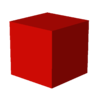
Cube
Truncated cube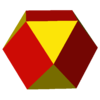
cuboctahedron
Truncated octahedron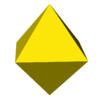
OctahedronThe cuboctahedron shares its edges and vertex arrangement with two nonconvex uniform polyhedra: the cubohemioctahedron (having the square faces in common) and the octahemioctahedron (having the triangular faces in common). It also serves as a cantellated Tetrahedron, as being a rectified Tetratetrahedron.

Cuboctahedron
Cubohemioctahedron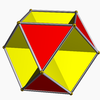
OctahemioctahedronName tetrahedron rectified tetrahedron
(octahedron)truncated tetrahedron cantellated tetrahedron
(cuboctahedron)omnitruncated tetrahedron
(truncated octahedron)Snub tetrahedron
(icosahedron)Schläfli {3,3} t1{3,3} t0,1{3,3} t0,2{3,3} t0,1,2{3,3} s{3,3} Coxeter-Dynkin 





























Graph
(A3)





Graph
(A2)





Solid 





Tiling 





The cuboctahedron 2-covers the tetrahemihexahedron,[3] which accordingly has the same abstract vertex figure (2 triangles and two squares: 3.4.3.4) and half the vertices, edges, and faces. (The actual vertex figure of the tetrahemihexahedron is 3.4.3/2.4, with the a/2 factor due to the cross.)

Cuboctahedron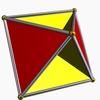
TetrahemihexahedronRelated polytopes
The cuboctahedron can be decomposed into a regular octahedron and eight irregular but equal octahedra in the shape of the convex hull of a cube with two opposite vertices removed. This decomposition of the cuboctahedron corresponds with the cell-first parallel projection of the 24-cell into 3 dimensions. Under this projection, the cuboctahedron forms the projection envelope, which can be decomposed into 6 square faces, a regular octahedron, and 8 irregular octahedra. These elements correspond with the images of 6 of the octahedral cells in the 24-cell, the nearest and farthest cells from the 4D viewpoint, and the remaining 8 pairs of cells, respectively.
Cultural occurrences
- In the Star Trek episode "By Any Other Name", aliens seize the Enterprise by transforming crew members into inanimate cuboctahedra.
- The "Geo Twister" fidget toy [1] is a flexible cuboctahedron.
See also
References
- Williams, Robert (1979). The Geometrical Foundation of Natural Structure: A Source Book of Design. Dover Publications, Inc. ISBN 0-486-23729-X. (Section 3-9)
- Richter, David A., Two Models of the Real Projective Plane, http://homepages.wmich.edu/~drichter/rptwo.htm
External links
- The Uniform Polyhedra
- Virtual Reality Polyhedra The Encyclopedia of Polyhedra
- Eric W. Weisstein, Cuboctahedron (Archimedean solid) at MathWorld.
- Richard Klitzing, 3D convex uniform polyhedra, o3x4o - co
- Editable printable net of a Cuboctahedron with interactive 3D view
Polyhedron navigator Platonic solids (regular) Archimedean solids
(Semiregular/Uniform)Catalan solids
(Dual semiregular)triakis tetrahedron · rhombic dodecahedron · triakis octahedron · tetrakis cube · deltoidal icositetrahedron · disdyakis dodecahedron · pentagonal icositetrahedron · rhombic triacontahedron · triakis icosahedron · pentakis dodecahedron · deltoidal hexecontahedron · disdyakis triacontahedron · pentagonal hexecontahedronDihedral regular Dihedral uniform Duals of dihedral uniform Dihedral others Degenerate polyhedra are in italics.Categories:- Archimedean solids
- Quasiregular polyhedra
- Heptaparallelohedron (Buckminster Fuller)[1]
Wikimedia Foundation. 2010.








